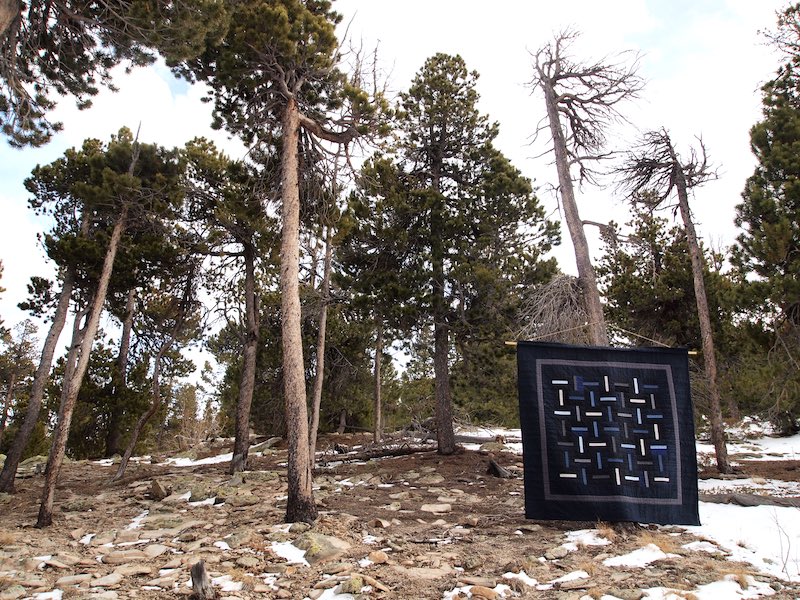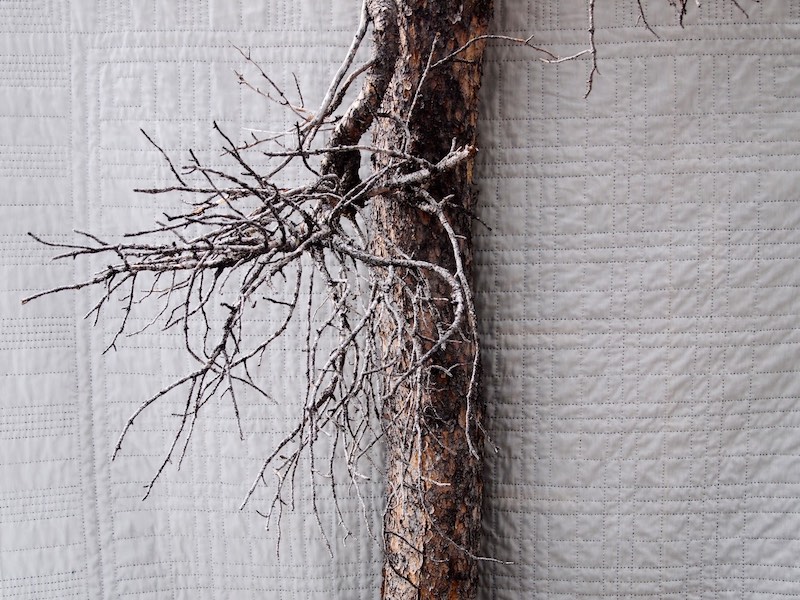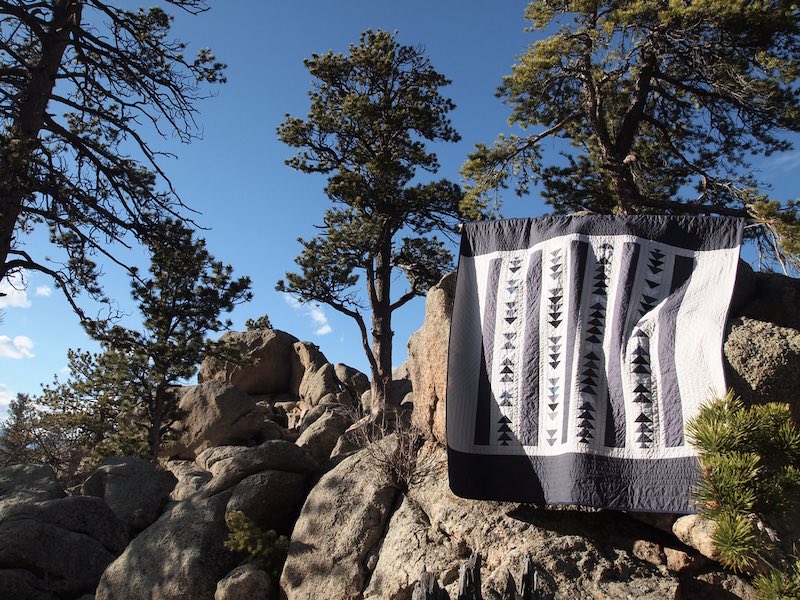With a background in photography and an admiration for the Gee’s Bend quilters, Shelby Skumanich mixes her trained compositional eye with the freedom of improvisation. The resulting quilts are striking blasts and nuances of color that capture the imagination.

What inspires you to create?
Nature and personal experience. I draw a lot of my color concepts from my experiences of nature and the emotional impression of place, as well as my internal life. My improvisational quilts align with a lot of the concepts of the Abstract Expressionist movement of the mid-20th century. Improvisation allows me to respond from intuition and emotion, so the quilts I make are expressions of my internal life.
Why textiles? How did you get started?
Textiles are one of the most intimate materials to work with; they live close to our bodies from birth to death, so they have a particular intimacy to them that I love. A quilt is a personal comfort object, as it holds the body during rest, sickness, and other moments in life that are about comfort and safety. I got started making quilts pretty young. I made a lot of what I now understand to be improv patchwork bags and pillows and then made my first quilt at age of 16. It was part of larger practices that were rooted in DIY culture and the medium exploration I was doing at the time. I put it to the side when I went to art school and picked it up again when I was feeling really lost and unsure of a direction after my grandmother passed away in 2011.
As an Amazon Associate I earn from qualifying purchases. Read more about our affiliate linking policy.

How does your formal art education help your work develop? Does it ever get in the way?
My formal art education helped me approach learning and immersing myself in a new medium by giving me a framework. In order to make the work, I wanted to understand where in history I fit and the reasons that I choose what I do.
We don’t make in a vacuum and I think it’s important to understand who’s come before you and who your contemporaries are. I studied photography in school and it’s given me a unique sense of composition and how subtly placement of objects in the frame can make or break an image. It’s a hardwired understanding of what is visually compelling and the ability to see it immediately. It gets in the way when I take myself too seriously. Because art making, for me, is fundamentally a joyful experience.

Are there recurring themes in your work? What is it about a subject that inspires you to continue exploring it?
Right now, I’m exploring themes around the female body and the construct of femininity. I’m working on a series of three called Maiden/Mother/Crone, which explores the Jungian archetypes of the stages of a femme’s life and journey.
I have an ongoing exploration of the concept of home in my log cabin quilts. I have a tentative and strange relationship with home as a place and as a feeling. As I’ve grown into myself the last few years, I have been creating home and family in non-traditional ways and explore those feelings when I am making.



How has your creativity evolved over the years? What triggered the evolution to new media/kinds of work/ways of working? What have you learned about yourself in the process?
As I stated before, I studied photography in college, but I’ve also done a lot of digital work, bookmaking, screen printing, and creative writing. I’ve learned a lot about resiliency as well as what a gift my curiosity is.
I think our culture has this narrative that we have to pick one thing, we have to stick with it, and we have to become a master of it over the course of our lifetime. My art practice has given me permission to explore and to evolve, so it contains multitudes in my identity. I also think quilting has also given permission to be deeply embodied in my feminine self.
Because I was raised in the culture that we’re in, which is a patriarchy, I routinely rejected the “feminine” side of myself because our culture thinks that women are second-class citizens. As an extension of that, I also think that my quilting experience and the way that I work, which is improvisational, allowed me to examine my internalized racism. I’m really heavily inspired by the quilter’s of Gee’s Bend. On a macro level, learning their story is about learning this part of American history that many white Americans learned to ignore or to gloss over and pretend that the problems no longer exist. So I can’t make work in an improvisational style without seeing where I fit into the culture of white supremacy in America.


Do you have a dedicated space for creating? If so, what does it look like?
I do! And I feel really fortunate to have a dedicated creative space; I do share it with my home office as well as my adorable bunny rabbit named Elmer. It was my goal to have an extra bedroom in my living space for my studio. I’ve attached a photo.

What are the indispensable tools and materials in your studio? How do they improve your work?
The first would be my sewing machine, a Juki TL-2010Q. I wanted a simple, hardworking machine that made beautiful straight stitches as fast as possible and it meets those criteria. Otherwise I would say a really good quality pair of very sharp scissors, and fresh rotary blades. I tend to keep my tool set really simple.
Do you use a sketchbook or journal? How does that help your work develop?
I journal in the mornings, but that is more to clear my head and to get myself focused on whatever tasks I have ahead of me. The sketches I do make tend to be light color studies that I started doing from fabric scraps. They’re a good way for me to explore color in a non-committal way as well as take risks.

What plays in the background while you work? Silence? Music, audiobooks, podcasts, movies? If so, what kind?
Music wise, there’s a lot of Fleetwood Mac, Bruce Springsteen, Orville Peck and Future Islands. The audiobooks I tend to choose are science fiction narratives or spiritual or philosophical books. I also tend to call friends when I’m doing a lot of mindless work, like hand quilting or chain piecing. It’s a good way to keep connected.
When it comes to creating, are you more of a planner or an improviser? How do you make the leap from the idea in your head to the art you create?
A little bit of both. I tend to get ideas for quilts when I move fabric around or when things kind of end up next to one another in my studio. Then the idea develops out of that. I can kind of see the whole thing in front of me, but I also daydream about variations and what else I can do with it before sitting down to make.

Quilting: hand or machine? Why?
Both! When I do my quilting myself, I’ll choose one a year to hand quilt because I enjoy the process; it’s a meditative exercise for me. That said, if I’m making 4-6 quilts a year, then I don’t have time to hand quilt them all. When that happens I send them off to Eleventh House Quilt Studio.
Do you focus on one piece exclusively from start to finish? Or do you work actively on more than one project at a time?
I tend to have 2-4 quilts in process at a time. One is being pieced, while one waits to be sandwiched, another is waiting to be quilted, and the other is being hand quilted.



Is there a part of your process you enjoy most? Why?
My favorite is piecing. I love coming up with new compositions and playing with color. Once I get the idea out, I want to get it out of my head and into fabric. It’s the part that I love to disappear into for long periods of time.
The setting for your quilt photographs adds to their visual story. How do you decide where and how you will digitally capture your quilt’s image?
Thank you for noticing that! It’s a deliberate choice on my part. It largely has to do with color or the texture. I see a wall or a space that I’m interested in. Then I get excited about seeing a quilt in that space. I also love taking them outside because it’s a really cool juxtaposition between this soft, domestic object and the outside world.



Time machine. Where would you go and why? Who would you want to meet?
I’m kind of a hippie, so I probably go back to the mid 60s to the early 70s to San Francisco and Los Angeles. I would love to meet Janis Joplin.
Do you think that creativity comes naturally to people? Or do you think creativity is a skill that people can learn?
I think creativity is an innate skill. There are many different forms of creativity that get expressed through different people in unique ways. That said, I do think that you can choose to ignore it or develop it.


How can people overcome the challenges they feel to their creative ability?
Talk to other people. People that are better than you, people that are the same level as you. Ask them about their process and learn about their journey. Also join a community. Having other makers around you to learn from and to get feedback is instrumental in growing as a creative person and as an artist.

Tell us about your website. What do you hope people will gain by visiting?
My website is first and foremost an archive and resume of sorts. I wanted to have a place to have a collection of all of the work that I’ve done in my life. If you go through it, you’ll see there’s an entire blog archive, four complete photographic projects, and all of the quilts I’ve made in the last 7 years. I hope that people will experience the breadth of my artistic practice and get an understanding of my story.
Interview posted June 2021
Browse through more quilt stories and inspiration on Create Whimsy.
